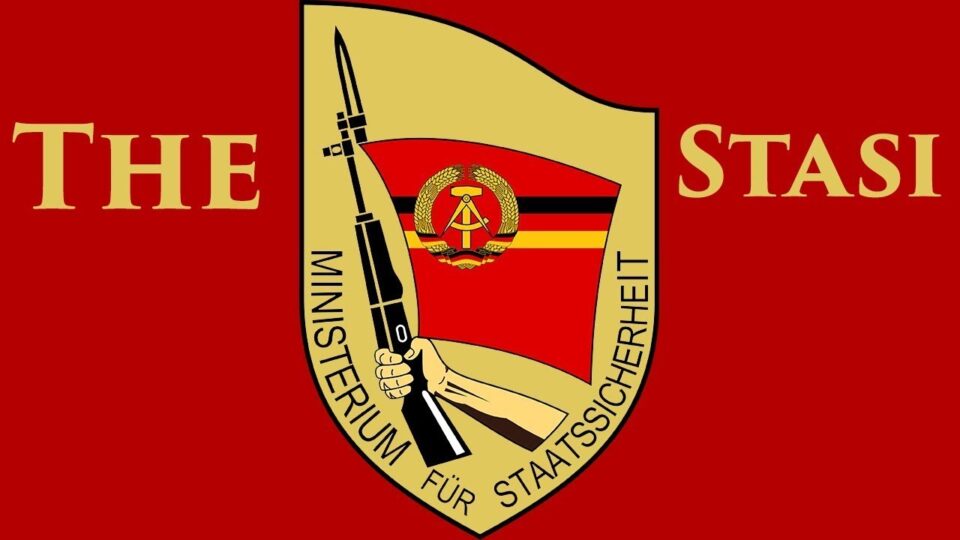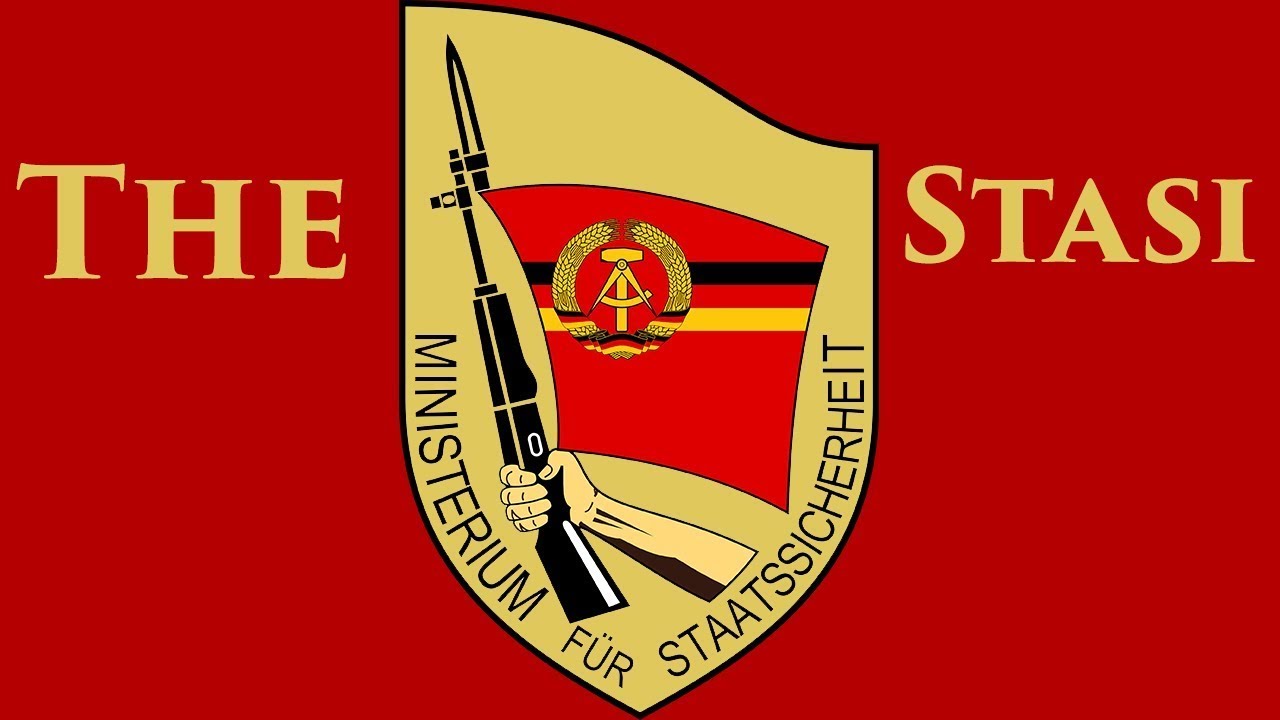Commonly known as Stasi or Ministerium fur Staatssicherheit (MfS), the Ministry for State Security was formed on 8th February 1950 as the official state intelligence for the German Democratic Republic (GDR). Research suggests that Stasi was one of the most effective and repressive intelligence service ever known to the world. Simon Wiesenthal from Austria has suggested that Stasi was considered to be worse than the Gestapo (Official Secret Police of Nazi Germany) as far as the oppression of own people was concerned (Koehler, 1999). Stasi inherited the internal security and police apparatus established after the Second World War in the Soviet side of Germany.
The core responsibilities of the Stasi were foreign intelligence and internal surveillance. The German Democratic Republic, as it was not formed on the principles of democracy, lived under constant fear of destabilization and this fear transformed Stasi into a fearsome organization that established its presence at all levels of society.
Stasi started its operations with around 17000 members, grew to 20000 in 1961 and its membership stood at 91015 in 1989 which was the last year of its operations (Wiel, 2014). Apart from the regular members, Stasi established a strong and extensive network of informants that started with 20000 people and reached up to around 173000 or more in 1989.
Stasi widely used interrogation techniques and psychological torture for its opponents. It turned out to be a complex organization which had many directorates with a particular set of expertise. The directorate HA-XXII was notorious for sabotage and planning terror plots in enemy territories. This directorate was also assigned to analyze activities of Republican groups in Northern Ireland. HVA (in charge of spying abroad) and HA-XXII are widely believed to have established and maintained contacts with terrorist outfits (Wiel, 2014).
3rd October 1990 was the historic day when the reunification of Germany took place, and East Germany formally ceased to exist. Stasi was dissolved following the fall of German Democratic Republic. The members of Stasi tried to destroy the secret files and records which was condemned by the general public and people even stormed Stasi Headquarters to not allowing Stasi destroy its records that could become significant evidence later against members of the secret service. The fate of the files was decided under the Unification Treaty between the German Democratic Republic and the newly formed Federal Republic of Germany and allowed access and use of the secret files. This step revealed shocking information regarding the Stasi- Terrorism nexus and its deplorable activities since its inception. To the present day, the evidence of Stasi’s support to European and related terrorism is rooted in three primary sources. Firstly, the secret files of Stasi recovered after the reunification of Germany (under the code names Stern I and Stern II). Secondly the nature of proceedings against the ex Stasi Officers in the Federal Republic to establish if charges of terrorism could be established against them, and finally the testimony of ten retired Red Army Faction (RAF) members who were secretly sheltered in East Germany by Stasi for around ten years and were now arrested and sent back (Schmeidel, 1993).
However, an essential discussion in their entire phenomenon is precisely what Stasi provided level and type of support to the terrorist outfits. According to the research by David Feilhaber, during the 1970’s the support of West German Armed group by Stasi was mostly indirect state-sponsored terrorism which reached to the next level in the 1980s. Still, the armed groups did not work as a proxy of Stasi, nor the agency directed their activities (Vielheber, 2013). On the other hand, other pieces of evidence and research suggest otherwise. Four Officers of Stasi were tried in court in 1997 for extending protection to Red Army Faction members. Henry Dahl, the former head of HA-XXII, was among them and admitted that Stasi provided shelter and other facilities to terrorists on the instruction of senior most officeholders in the German Democratic Republic. In April 1994, Mr. Voigt was sentenced to four years in prison as he had provided explosives to an associate of Carlos that resulted in the bombing of a French Cultural Center in West Germany in 1983. Voigt was an ex-Lieutenant Colonel at Stasi (Kinzer, 1994). This further strengthens the deep involvement and direct support of Stasi to terrorist outfits. An investigative German TV program in April 1991further demonstrated that Stasi’s involvement in killings was much more profound than it was thought. It is also a well-known fact, and numerous sources suggest that instructors from Stasi also provided training to terrorists who committed terrorist attacks in U.S Marine barracks in Lebanon in 1983. The Stasi files also revealed the presence of an elite East German hit squad and West German sleeper cells. All these points and many others imply the degree and magnitude of support of Stasi for terrorist outfits.
If we compare Stasi’s activities and Red Army Faction’s action to some of the other similar outfits such as Hezbollah, Al Qaeda etc.. We find many similar patterns and can draw some reasonable conclusions towards the Statsi – terrorism nexus. Iran, North Korea, Sudan, Syria, and in some cases Libya. Iran is widely seen to be involved in terrorist support activities and was designated as a State Sponsor of Terror in 1984 by the USA. The sponsorship of Iran is quite similar to Stasi as it also supports Palestinians terrorist groups (notably Hezbollah). Iran also supports Houthi separatists in Yemen and Shia oppositionists in Bahrain. Iran too provided weapons, training, and funding to Hamas, Iraqi Shia groups etc., Iran’s support for these groups has been mainly due to the prevailing ideology. Al Qaeda was also supported to a great extent by the Taliban Government where weapons, training, etc. were supplied to terrorist outfits.
Provision of complete support to terrorist outfits by Stasi was according to its goals and supervision from Soviet as well. Stasi’s supported was all-encompassing through funding radical magazines and newspapers against West Germany (ideological support), offered sanctuaries to Red Army Faction members and supplied them with weapons, bombs, and training, and safe passage through own airports (logistical support), fake passports and visas, intelligence support and excellent military-style training. The decline of the Red Army Faction, the Palestinian Liberation Organization following the decline of the German Democratic Republic also joins many dots. The presence of Carlos, Abu Nidal, George Habash, Abu Daoud in East Germany on various occasions also hints at the widely state-sponsored terrorism.
Red Army Faction (RAF) also known as Baader-Meinhof was a West German leftist terrorist group formed in 1968 and widely supposed to have received patron ship and support from Stasi. Peter Michael Diestel who was East Germany’s last Minister for Interior agreed in a TV Program in 1991 about Stasi being a postgraduate school and training headquarters for international terrorism. Stasi provided extensive assistance to RAF members, recruited them, and provided safe heavens to them in East Germany. In August 1970, Hans Jurgen who was one of the founding members of Stasi returned to Berlin and was arrested. He was interrogated by Stasi and revealed valuable information regarding RAF targets in West Germany such as U.S Army Headquarters and the office of Pan Am Airlines. Stasi not only not informed West about the attacks but also brought Jurgen secretly to West Germany, thus making a strong case for state-sponsored terrorism. Ulrike Meinhof, another founding member of RAF traveled to East Germany in 1970 to seek operational and strategic support for their objectives but was not encouraged for direct support from the authorities at that time. (Vielheber (2013). However, incidents that took place later prove direct support of Stasti in RAF’s activities. Another example of support of Stasi for RAF was the assassination of CEO of Deutsche Bank in 1989 where an infrared beam shining across the road was used to detonate explosives set up on the road. The Germans inability to investigate the attacks and the nature of the incident itself raised speculations about Stasi being behind RAF.
East German instructors also gave extensive training to RAF members in Southern Yemen, in camps. Claire Sterling, an Italian journalist, claimed that Stasi established RAF’s first safe house in East Germany in 1970 from where RAF members planned and carried out terrorist onslaught against Western Europe Notable incidents were killing of Jurgen Punto, Head of Dresdner Bank, kidnapping of Martin Schleyer, President of German Employers Association (Leighton, 2014). Department XXII headed by General Gerhard Neiber has sponsored care and feeding of RAF terrorists.
A notable female terrorist of RAF, Inge Viett, after her capture revealed that Stasi-RAF partnership properly started in 1978. She participated in the attempted assignation of General Alexander who was Commander in Chief of NATO and kidnapping of Peter Lorenz who was Head of Christian Democratic Union in West Germany. Viett was captured by German Democratic-Republican border guards while fleeing, and through Colonel Harry Dahl (Stasi), she was introduced to General Neiber (Stasi) and finally permitted to enter East Germany. She arranged for the other two colleagues from RAF to join her (Schweizer, 2003). She confessed that Stasi gave her and other RAF members a six-week weapons training course in March 1981 supervised by Norbert Wetzel and Hans Dieter (Stasi officials). They were also trained to manufacture fuses and detonate explosives. April 1991 edition of Der Spiegel claimed that Stasi taught possibilities of electromechanical and electronic detonation of bombs. RAF members involved in all significant terrorist incidents including the bombing of U.S Barracks in 1981 were Statsi beneficiaries. Stasi also taught the use of poisons and laser beams to RAF terrorists and such tactics were widely used later such as the killing of Karl Heinz, a senior executive at Siemens AG. Use of cardiac poisons, anesthetics for filling bullets, lethal nerve poisons and toxic substances in food and drinks, poisons leading to spasms were all used by RAF members and widely attributed to Stasi’s trainers. Viett and many of her colleagues were given fake identities to live in East Germany and were captured following the fall of East Germany. RAF has been a significant terrorist partner of Stasi (Leighton, 2014). It is important to note that what Stasi and RAF became close partners as they perceive it their joint struggle against West Germany, something they call as global imperialism. This partnership encouraged by Soviet against the Americans. Stasi and RAF both fought together for a global revolution that supported the Soviet agenda (Vielheber, 2013).
Stasi’s terror partnership was not limited to RAF. It was assigned by the Soviet Union to the Middle East and Africa too. Stasi provided arms and military training to Soviet allies such as Angola, Mozambique, and Ethiopia. East Germans also provided terrorist training at camps in Libya (Leighton, 2014).
Support for Palestine Liberation Organization (PLO) by East Germany is another prominent chapter in the history of Stasi, and it forms an essential part of European Terrorism in that era. In 1973 East Germany became the first country to allow PLO to open its office in its capital city. However, Stasi had limited its support to PLO for only carrying out terrorist activities against Israel and not West Germany as that could have brought reputational damage to East Germany and could have confirmed its image as a state sponsor of terror against West Germany. Stasi sought support from PLO and Arafat to prevent unnecessary attacks on West Germany (Herf, 2017). However, when radical militant factions broke away from PLO such as Abu Nidal Organization (ANO), Black September (the perpetrator of notorious Munich Olympics Massacre in 1972) and Carlos the Jackal. These factions were purely terrorist organizations and were trained to crash trucks and cars in buildings by East Germany. The terrorists who drove explosive-laden vehicles in American Marine barracks in Lebanon 1983 were also reportedly trained by East Germans (Leighton, 2014). ANO terrorists were trained by East German instructors by Stasi in 1985 on use of missiles and rocket launchers (Wolf and McElvoy, 1997). On 23rd April 1991, a German TV broadcast referred to the Kallinchen Training Camp that was a training site for Stasi for Abu Nidal operatives. The training comprised of education in politics, physical and combat training, automatic weapons, vehicles, communications etc., Following the completion of their training, ANO carried out many attacks at Rome and Vienna airports, thus adding fuel to the European terrorism, a result of direct support from Stasi. ANO’s activities were financed through Zibado, a trading company established in East Germany in 1884 (Leighton, 2014).
Carlos the Jackal was another client of Stasi. Carlos also separated from the PLO like ANO and stayed in East Germany from 1980 to 1983 in a Yemeni diplomat’s flat. Carlos was given an exceptional treatment as a distinguished guest in East Germany, on direct orders from Erick Honecker, Chief of Stasi and was free to carry out his terrorist activities. Maison de France bombing on 25th August 1983 in West Berlin also took place with direct support from Stasi. It was revealed from the arrest warrant of Helmut Voigt, a former Stasi Officer. He was convicted of supplying 20 to 30 kilos of explosives to terrorists. Carlos’s girlfriend is known to have masterminded the bombing (Leighton, 2014).
Stasi is also said to have been involved in the La Belle disco bombing as it had the prior knowledge of the plan and also tried to cover up Libya’s involvement. The attack killed two American servicemen, a Turkish woman and injured 23 people. 50 American military personnel was also wounded. Interception of messages from Libyan People’s Bureau in East Germany provided evidence of Libyan involvement in the attacks, and President Reagan ordered a military strike against Qaddafi’s Headquarters in Libya. Terrorist places in Benghazi were also targeted (Kempster, 1986). The casualties included Qaddafi’s adopted daughter whose revenge was taken by Libya through masterminding of Pan Am flight 103 in December 1998 with 270 passengers onboard.
Amongst all this discussion of Stasi’s support for terrorism in Europe, it will be interesting to note some of the main reasons and motives of Stasi behind this support and sponsorship of terrorism. Firstly, Stasi and RAF shared a common interest in political and economic destabilization of free Western societies. Secondly due to the definite ideological sympathies of East Germany. However, the RAF and the Movement of the Second of June both worked with Stasi under a relationship which was not always primarily based on ideological affinity. The left-wing terrorist outfits of West Germany have more interest and motivation from Che Guevara, guerrilla warfare and Cuban Model instead of the Communism ways and models that were widely practiced by East Germany. However, the Cold War made East Germany a potential ally for West Germany based terrorist outfits. The primary driving force was the need for support which was quickly and readily available from East Germany. The need for nearby safe heaven created strong interests among terrorist outfits for East Germany. Thirdly, The RAF and Stasi shared the hatred for bourgeois democracy which became a standard connection between the two due to their common ethnicity, language, etc. Fourthly, The Americans and Soviets have always struggled for control of Europe and this made the continent a battleground between the 1940s to early 1990s. The communists have always fought in Europe intending to spread Marxism. Thus the ideologically motivated terrorism took its roots from this Cold war conflict in Europe.
The relationship between Stasi and RAF and other terrorist outfits was quite natural. As an active intelligence service, Stasi was interested in crucial information that could affect politics and countries. In this regard, RAF’s goals, structure, etc., must have been of prime interest for Stasi (Hansen, 2008). Furthermore, the debriefings of former RAF members in 1980 have advantaged Stasi in its operations against West Germany. For example, from Inge Viett Stasi received information about prospects of a West European Guerrilla. Stasi was not just interested in information but also in maintaining instead increasing its influence in the Near East (Horchem, 1991).
One must take into account the interests of the Soviet Union and Stasi had to give them preference. Soviets have been keeping a close eye on the terrorist activities in their domain. Their goal was to anticipate and calculate the influence of Shiite Islam in their Muslim States. There is a strong possibility that Stasi maintained deep relations with West German terrorist outfits in order to facilitate their Soviet partners with crucial information about groups and the links between European and Near East organizations (Horchem, 1991).
Another essential motive of support for Western German terrorist was a political motivation. The terrorism was directed against a particular political or military mindset or philosophy. West German, Palestinian and Arab terrorist outfits were perfect partners for Stasi against the common enemy, which was Europe and Capitalists system. For Stasi, it was critical to maintaining this alliance with terrorists in order to keep an upper hand and a closer look at West Germany, the common enemy.
The marriage of convenience mostly defined the relationship between West German terrorists and Stasi, rooting out from Stasi’s discipline and ideology. Addiction to violence was another common characteristic between both parties. Soviets have always tried to promote a balance of power in the region that required East Germany to collaborate with terrorists who had already proved to be good partners by attacking North Atlantic Treaty Organization (NATO) targets. The Stasi and terrorist outfit’s partnership helped ensure the survival of Soviet bloc (Horchem, 1991).
The investigation into the Pan Am Flight 103 bombing in 1988 took a new turn when the involvement of Stasi was speculated in it. The clue emerged from the source of a fragment from the bomb timing devise which was manufactured by Mebo AG, a German form. Edwin Bollier, a director from the German firm, claimed that he had delivered such timers to East Germany in 1985 and they may have given them to Lockerbie bombers. The German police investigated the claim but found no substantial evidence to support Edwin’s claim. Officials from Bunderskiminalamtes (BKA), the German investigative agency, have dismissed the link of Stasi with the bombing. Officials in America and the United Kingdom remain in doubt about Stasi’s connection with the Lockerbie bombing (the Stasi Connection, 1994).
It will be interesting to discuss that alliance between East German, and the terrorist outfits were not strong enough and for some reasons was quite fragile. One of the main reasons for this was due to having different political agendas. It was a partnership between Marxism from Moscow and Maoist ideology of terrorists. This made the alliance very complicated.
Irish Republican Army (IRA) represented paramilitary movements in Ireland that started in 1920 dedicated to the independence of Ireland from Britain. Northern Ireland and its perceptions of East Germany were rooted in the Sozialistische Einheitspartei Deutschlands (SED) own political agendas. In the early 1970s, German Democratic Republic tried to use the activities if crown forces in Northern Ireland to undermine the democracy in Britain. This was done in the same way as unemployment in North England was used against Britain’s social policies. East Germany had always expressed an interest in Northern Ireland to discredit Britain politically. They did not have any real interest in Northern Ireland itself (Berger and Laporte, 2005). The troubles of Northern Ireland in 1960 have provided East Germany with propaganda material against British which reduced the moral authority of the later to criticize East Germany’s political deficiencies. The Department XXII of Stasi handled its relations with the Irish Republican Army and other terrorist groups (Leighton, 2014). IRA and its factions had close ties with other terrorist groups such as PLO and received weapons from Libya, the Soviet Union, and Yemen. Stasi maintained a high degree of intelligence about IRA including members of the IRA. During the intelligence operations in Britain, Stasi gathered information on how British intelligence recruited agents in Ireland, money transfers and ties with other countries. The fact that RAF, IRA, and PLO were involved in joint operations and training suggests that Stasi would have supported IRA in the way it supported other terrorist outfits. IRA was a natural ally for East Germany against the British. Evidence also suggests that a Stasi agent based in London in 1980 may have trained IRA operatives. Stasi produced many reports on IRA’s activities (Stasi’s IRA files suggest CIA Link, 1996).
To sum up, we may conclude that although almost definitive evidence does not exist in support of Stasi’s sponsorship of European terrorism but there is enough material available to carry on a healthy discussion and draw conclusions especially in case of Stasi’s support for RAF and enough news reports available for a healthy discussion on Stasi’s relationship with IRA. Similarities were found between Stasi’s terrorist support and other nations such as Qaddafi’s Libyan support and Iranian’s state support for terrorist outfits and Europe and the Middle East. Based on the news reports and working pattern of Stasi, it can be concluded that Stasi had offered support to IRA in the same fashion that it did for RAF and Arab terrorist outfits. The fact that IRA and RAF conducted joint attacks on British bases, also hints at the support of Stasi for IRA. The ideology and Soviet patron ship of East Germany, its state objectives, structure, etc. all indicate a strong link with IRA, especially against British imperialism. There is no doubt in the fact that Stasi supported terrorist outfits due to its ideology, resources, objectives, convenience etc., In fact Stasi’s support for European terrorist outfits must have been motivated by West Germany’s animosity and the fact that Stasi supported Arab terrorist outfits that had very close relations with RAF and other European terrorists. Specialized attacks such as the one on General Frederick in 1981 almost confirmed the role of Stasi in supporting terrorism. However, how IRA was supported is still a matter of discussion and research due to lack of substantive evidence and burning of Stasi documents. However, the motive of facilitating collapse of Capitalism was always there. The relationship between states sponsoring terrorism and terrorist groups is often very complex, subject to quick shifts and change in sides and motivation.
Mohammad Touseef FTIC GGA is the Director General of Westminster Centre for Research and Strategy.





